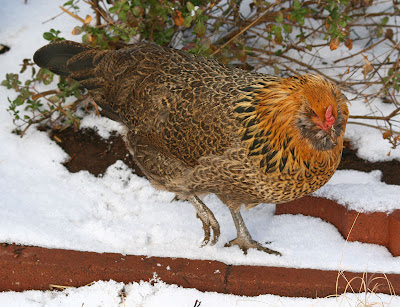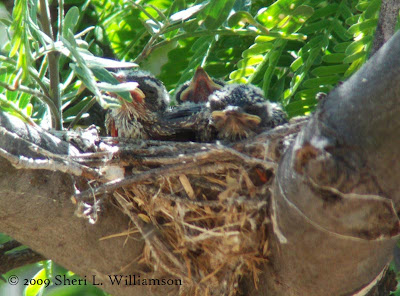
After one of the worst "monsoons" on record and a virtually rainless fall, we'll take our precipitation any way we can get it. Melting, it registered .35" - not too bad.
It's the chickens' first snow, so I let them out to scratch around in it.
 While supervising their explorations, I noticed that the hummingbird feeder was caked with snow. The feeder went dry while we were away for a few days, and I hadn't seen or heard a hummer since we returned, but I dutifully minced through the slush and brushed the ports clear. I hadn't taken three steps back when a male Anna's appeared out of nowhere.
While supervising their explorations, I noticed that the hummingbird feeder was caked with snow. The feeder went dry while we were away for a few days, and I hadn't seen or heard a hummer since we returned, but I dutifully minced through the slush and brushed the ports clear. I hadn't taken three steps back when a male Anna's appeared out of nowhere. Within a half hour a female Anna's and a Violet-crowned also came to drink, so I guess they've forgiven us for neglecting them while we were away watching other hummingbirds.
Within a half hour a female Anna's and a Violet-crowned also came to drink, so I guess they've forgiven us for neglecting them while we were away watching other hummingbirds.The chickens are only allowed out when we're there to supervise. We love our chickens, but we also love our raptor neighbors and don't want to lead them into temptation. We haven't noticed regular visits from the Cooper's Hawk that used our water feature as her personal spa the last two winters, but the local Red-tail is a proven bird hunter. One morning as I stepped out to check on the chickens, a flutter caught my eye. There was the Red-tail atop a nearby utility pole. Hey, neighbor, I thought. Another flutter, and a double-take: the hawk wasn't alone.
 He can have all the pigeons he wants, and I've never caught him eyeing the girls, but better safe than sorry.
He can have all the pigeons he wants, and I've never caught him eyeing the girls, but better safe than sorry.





















